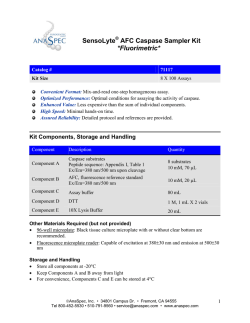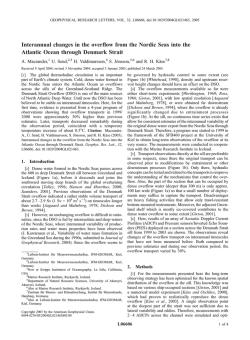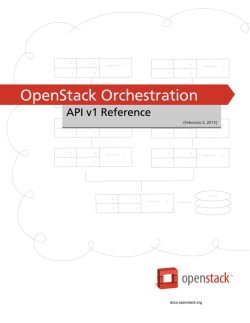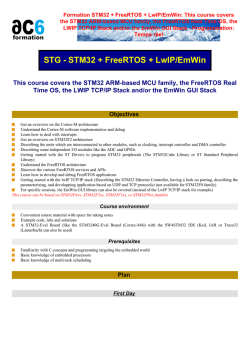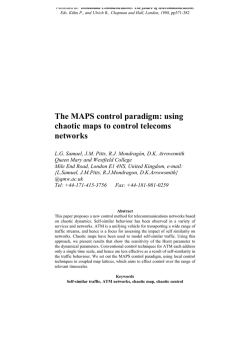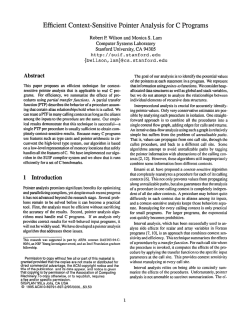
slides - CS Course Webpages
1/30/2015
CSCE 465 Computer & Network
Security
Instructor: Dr. Guofei Gu
http://courses.cse.tamu.edu/guofei/csce465/
Program Security:
Buffer Overflow
1
1/30/2015
Buffer Overflow
• BO Basics
• Stack smashing
• Other buffer overflow vulnerabilities
• BO Defense
BUFFER OVERFLOW BASICS
2
1/30/2015
Introduction
• What is a buffer overflow?
– A buffer overflow occurs when a program writes
data outside the bounds of allocated memory.
• Buffer overflow vulnerabilities are exploited to
overwrite values in memory to the advantage
of the attacker
Impact
• Firstly widely seen in the first computer worm -- Morris
Worm (1988, 6,000 machines infected)
• Buffer overflow is still the most common source of
security vulnerability
• SANS (SysAdmin, Audit, Network, Security) Institute
report that 14/20 top vulnerabilities in 2006 are buffer
overflow-related
• Also behind some of the most devastation worms and
viruses in recent history e.g. Zotob, Sasser, CodeRed,
Blaster, SQL Slammer, Conficker, Stuxnet …
3
1/30/2015
BO Attacks
• Goal: subvert the function of a privileged
program so that the attacker can take control
of that program, and if the program is
sufficiently privileged, thence control the host.
• Involves:
– Code present in program address space
– Transfer execution to that code
Placing code in address space
• 2 ways to achieve subgoal:
– Inject user code
– Use what’s already there
4
1/30/2015
Code Injection
• Code Injection: provide a string as input to the
program, which the program stores in a buffer.
The string contains native CPU instructions for
the platform being attacked
• Works with buffers stored anywhere
Code already there
• Code of interest already in part of program
• Attacker only needs to call it with desired
arguments before jumping to it
• E.g. Attacker seeks to acquire a shell, but code
already in some library contains a call to
exec(arg). Attacker must only pass a pointer to
the string “/bin/sh” and jump to ‘exec’ call
5
1/30/2015
How to jump to Attacker Code
• Activation Records: stores return address of
function. Attacker modifies pointer to point to
his code. This technique is known as “stack
smashing”
• Function Pointers: similar idea, but seeks to
modify an arbitrary function pointer.
• Longjmp buffers: again, the attacker modifies
the buffer with his malicious code
Attacks on Memory Buffers
• Buffer is a data storage area inside computer memory (stack or
heap)
– Intended to hold pre-defined amount of data
• If more data is stuffed into it, it spills into adjacent memory
– If executable code is supplied as “data”, victim’s machine may be fooled
into executing it – we’ll see how
• Code will self-propagate or give attacker control over machine
• First generation exploits: stack smashing
• Second gen: heaps, function pointers, off-by-one
• Third generation: format strings and heap management
structures
6
1/30/2015
STACK SMASHING
Stack Smashing
• Process memory is organized into three regions : Text, Data
and Stack
• Text/code section (.text)
– Includes instructions and read-only data
– Usually marked read-only
– Modifications cause segment faults
• Data section (.data, .bss)
– Initialized and uninitialized data
– Static variables
– Global variables
• Stack section
– Used for implementing procedure abstraction
7
1/30/2015
Process Memory Structure
• Code/Text section (.text)
• Data section (.data, .bss)
• Heap section
– Used for dynamically allocated
data
• Stack section
• Environment/Argument
section
– Used for environment data
– Used for the command line data
What Happens When Memory
Outside a Buffer Is Accessed?
• If memory doesn't exist:
–Bus error
• If memory protection denies access:
–Page fault
–Segmentation fault
–General protection fault
• If access is allowed, memory next to the buffer can
be accessed
–Heap
–Stack
–...
8
1/30/2015
Stack Frame
• The stack usually grows
towards lower memory
addresses
• The stack is composed of
frames
• The stack pointer (SP) points
to the top of the stack
(usually last valid address)
Parameters
Return address
Stack Frame Pointer
Local variables
SP (%esp)
Stack
Growth
Stack Buffers
• Suppose Web server contains this function
void func(char *str) {
char buf[126];
strcpy(buf,str);
}
Allocate local buffer
(126 bytes reserved on stack)
Copy argument into local buffer
• When this function is invoked, a new frame
with local variables is pushed onto the stack
Stack grows this way
buf
Local variables
sfp
ret
addr
Pointer to
Execute
previous
code at
frame
this address
after func()
finishes
str
Frame of the
calling function
Top of
stack
Arguments
9
1/30/2015
What If Buffer Is Overstuffed?
• Memory pointed to by str is copied onto
stack…
void func(char *str) {
char buf[126];
strcpy(buf,str);
}
strcpy does NOT check whether the string
at *str contains fewer than 126 characters
• If a string longer than 126 bytes is copied into
buffer, it will overwrite adjacent stack locations
buf
overflow
str
Frame of the
calling function
Top of
stack
This will be
interpreted
as return address!
Executing Attack Code
• Suppose buffer contains attacker-created string
– For example, *str contains a string received from
the network as input to some network service
daemon
code
Attacker puts actual assembly
instructions into his input string, e.g.,
binary code of execve(“/bin/sh”)
ret
str
Frame of the
calling function
Top of
stack
In the overflow, a pointer back
into the buffer appears in
the location where the system
expects to find return address
• When function exits, code in the buffer will be
executed, giving attacker a shell
– Root shell if the victim program is setuid root
10
1/30/2015
The Shell Code
void main() {
char *name[2];
name[0] = "/bin/sh";
name[1] = NULL;
execve(name[0], name, NULL);
exit(0); }
• System calls in assembly are invoked by saving
parameters either on the stack or in registers and
then calling the software interrupt (0x80 in Linux)
Attack Procedure High Level View
• Compile attack code
• Extract the binary for the piece that actually does
the work (shell code)
• Insert the compiled code into the buffer
• Figure out where overflow code should jump
• Place that address in the buffer at the proper
location so that the normal return address gets
overwritten
11
1/30/2015
Buffer Overflow Issues
• Executable attack code is stored on stack,
inside the buffer containing attacker’s string
– Stack memory is supposed to contain only data, but…
• Overflow portion of the buffer must contain
correct address of attack code in the RET
position
– The value in the RET position must point to the beginning of attack
assembly code in the buffer
• Otherwise application will crash with segmentation violation
– Attacker must correctly guess in which stack position his buffer will be
when the function is called
Guessing the Buffer Address
• In most cases the address of the buffer is not known
• It has to be “guessed” (and the guess must be very precise)
• Given the same environment and knowing size of
command-line arguments the address of the stack can
be roughly guessed
• The stack address of a program can be obtained by using the
function
unsigned long get_sp(void) {
__asm__("movl %esp,%eax");
}
• We also have to guess the offset of the buffer with
respect to the stack pointer
12
1/30/2015
NOP Sled
• Use a series of NOPs at the beginning of the
overflowing buffer so that the jump does not
need to be exactly precise
• This technique is called no-op sled
OTHER BO VULNERABILITIES
13
1/30/2015
Off-By-One Overflow
• Home-brewed range-checking string copy
void notSoSafeCopy(char *input) {
char buffer[512]; int i;
This will copy 513
characters into
buffer. Oops!
for (i=0; i<=512; i++)
buffer[i] = input[i];
}
void main(int argc, char *argv[]) {
if (argc==2)
notSoSafeCopy(argv[1]);
}
1-byte overflow: can’t change RET, but can change
pointer to previous stack frame
– On little-endian architecture, make it point into buffer
– RET for previous function will be read from buffer!
Heap Overflow
• Overflowing buffers on heap can change
pointers that point to important data
– Sometimes can also transfer execution to attack code
– Can cause program to crash by forcing it to read from an
invalid address (segmentation violation)
• Illegitimate privilege elevation: if program with
overflow has sysadm/root rights, attacker can
use it to write into a normally inaccessible file
– For example, replace a filename pointer with a pointer into
buffer location containing name of a system file
• Instead of temporary file, write into AUTOEXEC.BAT
14
1/30/2015
Function Pointer Overflow
• C uses function pointers for callbacks: if pointer
to F is stored in memory location P, then
another function G can call F as (*P)(…)
Heap
Buffer with attacker-supplied
input string
Callback
pointer
attack code
overflow
Legitimate function F
(elsewhere in memory)
Format Strings in C
• Proper use of printf format string:
… int foo=1234;
printf(“foo = %d in decimal, %X in hex”,foo,foo); …
• This will print
foo = 1234 in decimal, 4D2 in hex
• Sloppy use of printf format string:
… char buf[13]=“Hello, world!”;
printf(buf);
// should’ve used printf(“%s”, buf); …
• If buffer contains format symbols starting with %, location
pointed to by printf’s internal stack pointer will be
interpreted as an argument of printf. This can be
exploited to move printf’s internal stack pointer.
15
1/30/2015
Writing Stack with Format Strings
• %n format symbol tells printf to write the number of characters
that have been printed
… printf(“Overflow this!%n”,&myVar); …
• Argument of printf is interpeted as destination address
• This writes 14 into myVar (“Overflow this!” has 14 characters)
• What if printf does not have an argument?
… char buf[16]=“Overflow this!%n”;
printf(buf); …
• Stack location pointed to by printf’s internal stack pointer will be
interpreted as address into which the number of characters will be
written
More Buffer Overflow Targets
• Heap management structures used by malloc()
• URL validation and canonicalization
– If Web server stores URL in a buffer with overflow, then attacker can gain
control by supplying malformed URL
• Nimda worm propagated itself by utilizing buffer overflow in
Microsoft’s Internet Information Server
• Some attacks don’t even need overflow
– Naïve security checks may miss URLs that give attacker access to
forbidden files
• For example, http://victim.com/user/../../autoexec.bat may pass
naïve check, but give access to system file
• Defeat checking for “/” in URL by using hex representation
16
1/30/2015
BO DEFENSE
Buffer Overflow Defenses
• Writing correct code
• Non-executable buffers
• Randomize stack location or encrypt return
address on stack by XORing with random
string
– Attacker won’t know what address to use in his
string
• Array bounds checking
• Code pointer integrity checking
17
1/30/2015
Writing correct code
• Use safe programming languages, e.g., Java
– What about legacy C code?
• Use compilers that warn about linking to
unsafe functions e.g. gcc
• Static analysis of source code to find overflows
• Black-box testing with long strings
• Use safer versions of functions
e.g., gets and strcpy should be replaced with
getline and strlcpy
Problem: No Range Checking
• strcpy does not check input size
– strcpy(buf, str) simply copies memory contents
into buf starting from *str until “\0” is
encountered, ignoring the size of area allocated to
buf
• Many C library functions are unsafe
–
–
–
–
–
strcpy(char *dest, const char *src)
strcat(char *dest, const char *src)
gets(char *s)
scanf(const char *format, …)
printf(const char *format, …)
18
1/30/2015
Does Range Checking Help?
• strncpy(char *dest, const char *src, size_t n)
– If strncpy is used instead of strcpy, no more than n
characters will be copied from *src to *dest
• Programmer has to supply the right value of n
• Potential overflow in htpasswd.c (Apache 1.3):
… strcpy(record,user);
strcat(record,”:”);
strcat(record,cpw); …
Copies username (“user”) into buffer (“record”),
then appends “:” and hashed password (“cpw”)
• Published “fix” (do you see the problem?):
… strncpy(record,user,MAX_STRING_LEN-1);
strcat(record,”:”);
strncat(record,cpw,MAX_STRING_LEN-1); …
Misuse of strncpy in htpasswd “Fix”
• Published “fix” for Apache htpasswd overflow:
… strncpy(record,user,MAX_STRING_LEN-1);
strcat(record,”:”);
strncat(record,cpw,MAX_STRING_LEN-1); …
MAX_STRING_LEN bytes allocated for record buffer
contents of *user
Put up to MAX_STRING_LEN-1
characters into buffer
:
Put “:”
contents of *cpw
Again put up to MAX_STRING_LEN-1
characters into buffer
• Note: Strlcpy can count and return the length of
the entire source string while strncpy cannot
19
1/30/2015
Bugs to Detect in Source Code Analysis
• Some examples
• Crash Causing Defects
• Null pointer dereference
• Use after free
• Double free
• Array indexing errors
• Mismatched array new/delete
• Potential stack overrun
• Potential heap overrun
• Return pointers to local variables
• Logically inconsistent code
• Uninitialized variables
• Invalid use of negative values
• Passing large parameters by value
• Underallocations of dynamic data
• Memory leaks
• File handle leaks
• Network resource leaks
• Unused values
• Unhandled return codes
• Use of invalid iterators
Non-executable buffers
• Works by marking a region of memory as nonexecutable. To stop buffer overflow, exploits,
the data section has to be marked nonexecutable.
• Problem with recent systems, since they emit
executable code within the data section, but
more applicable to stack segment since no
legitimate program has code in stack.
20
1/30/2015
Non-Executable Stack
• NX bit on every Page Table Entry
– AMD Athlon 64, Intel P4 “Prescott”, but not 32-bit x86
– Code patches marking stack segment as non-executable
exist for Linux, Solaris, OpenBSD
• Some applications need executable stack
– For example, LISP interpreters
• Does not defend against return-to-libc exploits
– Overwrite return address with the address of an
existing library function (can still be harmful)
• …nor against heap and function pointer
overflows
Address Randomization: Motivations.
• Buffer overflow and return-to-libc exploits need to
know the (virtual) address to which pass control
– Address of attack code in the buffer
– Address of a standard kernel library routine
• Same address is used on many machines
– Slammer infected 75,000 MS-SQL servers using same
code on every machine
• Idea: introduce artificial diversity
– Make stack addresses, addresses of library routines, etc.
unpredictable and different from machine to machine
21
1/30/2015
Address Space Layout Randomization
• Arranging the positions of key data areas randomly in
a process' address space.
– e.g., the base of the executable and position of libraries
(libc), heap, and stack,
– Effects: for return to libc, needs to know address of the key
functions.
– Attacks:
• Repetitively guess randomized address
• Spraying injected attack code
• Vista/Windows 7 has this enabled, software packages
available for Linux and other UNIX variants
Array bounds checking
• Completely stops BO attacks
• All reads and writes to arrays will be bound
checked. This is the case with memory-safe
languages like Java and .net languages
• Solves the problem at the cost of performance
22
1/30/2015
Run-Time Checking: Libsafe
• Dynamically loaded library
• Intercepts calls to strcpy(dest,src)
– Checks if there is sufficient space in current stack
frame
|frame-pointer – dest| > strlen(src)
– If yes, does strcpy; else terminates application
sfp ret-addr
libsafe
dest
src
buf
sfp ret-addr
top
of
stack
main
Code pointer integrity checking
• Works by detecting whether a code pointer
e.g. return address, has been corrupted before
dereferencing it.
• Prevents only BO attacks exploiting automatic
buffers
• Much better performance than array bounds
checking
• Eg. StackGuard
23
1/30/2015
Run-Time Checking: StackGuard
• Embed “canaries” in stack frames and verify
their integrity prior to function return
– Any overflow of local variables will damage the
canary
buf
Local variables
canary
sfp
ret
addr
Frame of the
calling function
Top of
stack
Return
Pointer to
previous execution to
this address
frame
• Choose random canary string on program start
– Attacker can’t guess what the value of canary will be
• Terminator canary: “\0”, newline, linefeed, EOF
– String functions like strcpy won’t copy beyond “\0”
StackGuard Implementation
• StackGuard requires code recompilation
• Checking canary integrity prior to every function
return causes a performance penalty
– For example, 8% for Apache Web server
• PointGuard also places canaries next to function
pointers and setjmp buffers
– Worse performance penalty
• StackGuard can be defeated!
– Phrack article by Bulba and Kil3r
24
© Copyright 2026
